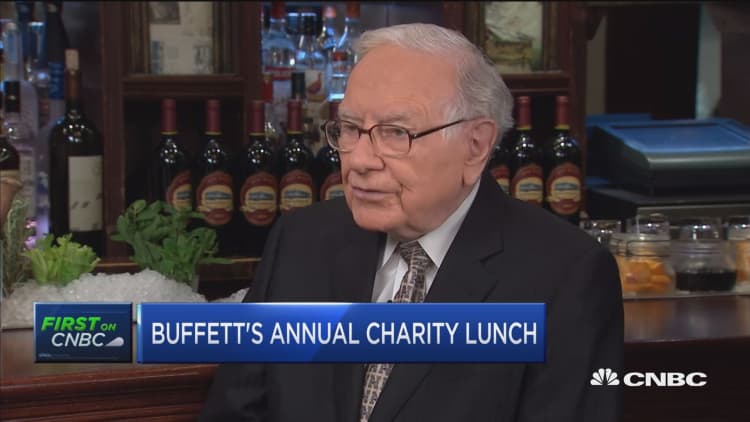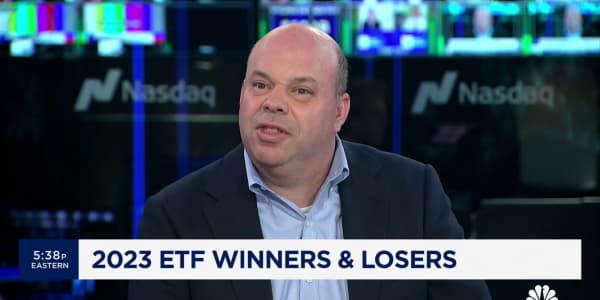Investors have long been sold on holding an S&P 500 index fund as the way to capture core U.S. stock market performance. Legendary Berkshire Hathaway Chairman and CEO Warren Buffett has said an index portfolio of 90 percent S&P 500 and 10 percent Treasurys would meet most investors needs. Vanguard Group founder Jack Bogle has noted that S&P 500 index funds even effectively provide international exposure, since large U.S.-based multinationals derive a significant percentage of their revenue from foreign sources.
They aren't wrong, but there might be a better option for investors seeking the simplest, broadest and most effective long-term bet on America: a total stock market index fund or ETF. Among the believers in the total stock market approach over the S&P 500: index fund giant Vanguard.
Last June, Vanguard Group removed the S&P 500 index fund from its own employee 401(k) retirement plan and replaced it with a total stock market index fund. The reason: The total stock market fund covers large-cap, mid-cap and small-cap stocks, while the S&P 500 covers only the large-cap universe.
The popularity of the total stock market approach also is taking place within Vanguard's ETF lineup. Vanguard's Total Stock Market ETF (VTI) recently became only the third ETF to pass the $100 billion mark in assets.
It is still far smaller than State Street's SPDR S&P 500 ETF (SPY), with $270 billion in assets, but it is larger than Vanguard's own S&P 500 ETF (VOO).
"For the average long-term investor, a total stock market fund is probably superior because of its added diversification," said Sumit Roy, a senior writer at ETF.com. "But for a more active investor or a trader with a more nuanced view of which types of stocks will perform better, the S&P 500 fund could be more appropriate."
The performance differential between the two is often minimal, because total stock market ETFs are typically market-cap weighted — even though they hold small- and mid-cap equity, large-cap holdings still make up the bulk of these funds. VTI includes 3,462 holdings — nearly five times as many as SPY — representing nearly the entire U.S. equity market, outside penny stocks. But an S&P 500 fund covers about 80 percent of the U.S. stock market.
Vanguard's S&P 500 ETF and the total stock market ETF have generated similar performance over the years and charge the same management fee of 0.04 percent.
S&P 500 vs. Total Market Index
| Return | Vanguard S&P 500 (VOO) | Vanguard Total Market Index (VTI) |
|---|---|---|
| YTD | 8.70% | 9.20% |
| 1-year | 18.70% | 19.50% |
| 3-year | 16.70% | 16.40% |
| 5-year | 13.90% | 13.70% |
| 10-year | 11.10% | 11.20% |
| 15-year | 9.40% | 9.70% |
Source: Morningstar, data as of 9/7/2018. All periods greater than one year are annualized returns. 10- and 15-year performance for VOO are S&P 500 Index performance.
VTI's greater diversification also means it is slightly riskier because of its smaller-cap holdings, said Neena Mishra, director of ETF research at Zacks Investment Research. But over the long term, that should benefit investors who don't hold multiple U.S. stock funds.
"For investors who do not own other small-cap stocks or ETFs in the portfolio, VTI is a better choice due to its more diversified exposure," Mishra said. Over time smaller companies have a history of outperforming larger ones, she added.
The S&P 500 remains a viable option, and either it or a total stock market portfolio can serve as an investor's core equity position, said Mitch Goldberg, president of investment advisory firm ClientFirst Strategy. He noted that there's a third option as well: ETFs that track the FTSE Global All Cap Index, which provides exposure to about 8,000 stocks globally, such as Vanguard's Total World Stock Index Fund (VT).
All three have the same top 10 holdings, but the concentration is greatest in the S&P 500, at 22 percent, versus 18 percent for the domestic total stock market index and about 10 percent for the global ETF.

The important decision is to choose only one and stick with it.
"Any one of them could outperform the others, depending on the market environment. But I would warn many investors that attempting to jump back and forth with these is probably going to result in worse long-term returns," Goldberg said.
Most of the major index fund and ETF companies offer this choice between an S&P 500 index fund or ETF and total stock market portfolio, including BlackRock's iShares, Charles Schwab and Fidelity Investments. When Fidelity recently made the decision to offer the industry's first-ever no-fee index fund, it chose its total stock market portfolio, not an S&P 500 one.
The benefit of questioning the S&P 500's ubiquity in portfolios is, ultimately, to reinforce the importance of core, long-term investing anchors at a time when there are thousands of ETFs.
"It's possible to create asset-allocation models that are exactly matched to a particular standard deviation, alpha and other metrics, because the ETF industry has sliced and diced stocks into so many categories, from broad-based indices to niche sectors. But is it worth it for an investor?" Goldberg said. "I think this makes investing overly complicated, which is why a broad-based ETF makes sense as an anchor or core position in a portfolio."
Selecting the one stock fund that best suits an investor's needs and sticking with it over the long term is the first step in creating an asset-allocation plan that also can include satellite holdings to gain diversification that a core holding lacks.
Global investments such as VT are a good way to get low-cost exposure to thousands of developed and emerging markets stocks, but probably are too broad to serve as a core holding for most U.S.-based investors, Mishra said, because of the significant weighting to overseas stocks. She advises between 15 percent to 25 percent of a core portfolio be invested in foreign equities and noted that VT has more than 45 percent of its assets invested in foreign equities, making it slightly aggressive for the core portfolio if held in place of SPY or VTI.
"Given higher volatility and foreign-exchange risks associated with global stocks, VT is more suitable as a satellite holding," she said.
—By Joe D'Allegro, special to CNBC.com




